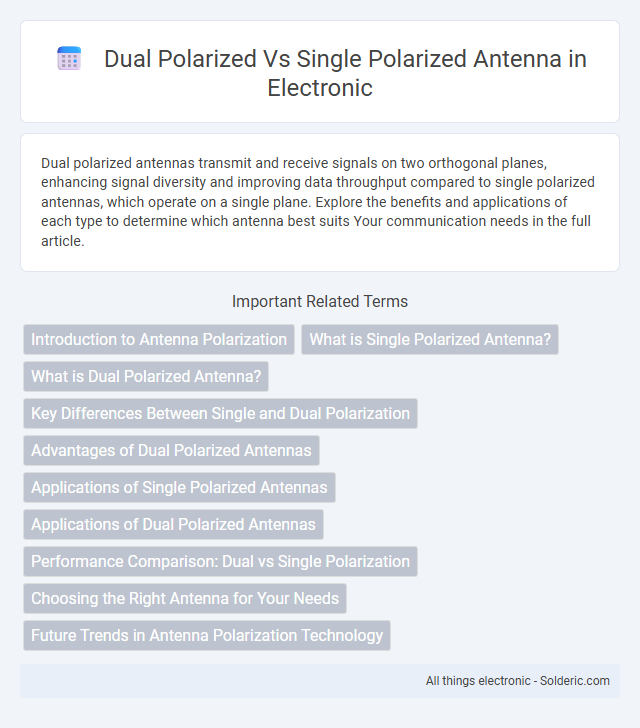Dual polarized antennas transmit and receive signals on two orthogonal planes, enhancing signal diversity and improving data throughput compared to single polarized antennas, which operate on a single plane. Explore the benefits and applications of each type to determine which antenna best suits Your communication needs in the full article.
Comparison Table
| Feature | Dual Polarized Antenna | Single Polarized Antenna |
|---|---|---|
| Polarization | Supports two orthogonal polarizations (usually horizontal & vertical) | Supports one polarization (either horizontal or vertical) |
| Signal Diversity | Improves signal quality and reduces multipath fading | Limited to single polarization, less robust signal |
| Bandwidth Efficiency | Higher spectral efficiency with MIMO capabilities | Lower spectral efficiency, no inherent MIMO advantage |
| Applications | Ideal for LTE, 5G, and advanced wireless systems | Suitable for simpler communication systems |
| Installation Complexity | More complex and costly | Simpler and less expensive |
| Size and Weight | Typically larger and heavier | Compact and lightweight |
Introduction to Antenna Polarization
Antenna polarization refers to the orientation of the electric field of the radio wave transmitted or received by an antenna, which significantly impacts signal quality and communication reliability. Single polarized antennas emit or receive signals in one fixed polarization, either vertical or horizontal, while dual polarized antennas support two orthogonal polarizations, improving signal diversity and reducing multipath interference. Choosing the right polarization for Your antenna system can enhance signal strength and minimize polarization mismatch losses in wireless communication networks.
What is Single Polarized Antenna?
A single polarized antenna transmits and receives radio waves with a single orientation of the electric field, typically either vertical or horizontal polarization. This type of antenna is simpler to design and is commonly used in applications where signal direction and polarization remain consistent. Single polarized antennas tend to have narrower coverage and may experience polarization mismatch losses in environments with varying signal orientations.
What is Dual Polarized Antenna?
A dual polarized antenna transmits and receives signals using two orthogonal polarization planes, typically horizontal and vertical, enhancing signal diversity and reducing multipath interference. This design improves data throughput and network reliability by enabling simultaneous dual-channel communication within the same frequency band. Your wireless system benefits from increased capacity and better performance in complex environments compared to single polarized antennas that use only one polarization plane.
Key Differences Between Single and Dual Polarization
Single polarized antennas transmit and receive signals using one polarization plane, typically vertical or horizontal, resulting in simpler design and reduced cost. Dual polarized antennas use two orthogonal polarization planes, allowing simultaneous transmission and reception of two independent signals, enhancing signal reliability and improving overall system capacity. Your choice depends on application needs, where dual polarization offers better performance in environments with multipath interference or polarization diversity.
Advantages of Dual Polarized Antennas
Dual polarized antennas offer enhanced signal reliability by transmitting and receiving electromagnetic waves in two orthogonal polarization planes, reducing multipath fading and interference. They improve spectrum efficiency and capacity in wireless communication systems by supporting multiple data streams and polarization diversity. These antennas are essential in MIMO systems, enabling better performance and higher throughput compared to single polarized antennas.
Applications of Single Polarized Antennas
Single polarized antennas are commonly used in applications where signal direction and polarization remain consistent, such as in terrestrial point-to-point communication and broadcast TV antennas. These antennas provide simpler design and cost efficiency while maintaining reliable performance in environments with minimal polarization mismatch. Their effectiveness in fixed wireless links and satellite communication arrays highlights their suitability for scenarios requiring stable, uniform polarization.
Applications of Dual Polarized Antennas
Dual polarized antennas are widely used in wireless communication systems such as LTE, 5G, and Wi-Fi to enhance signal reliability and increase data throughput by simultaneously transmitting and receiving signals in two orthogonal polarizations. These antennas improve performance in urban environments with multipath fading and reduce interference in MIMO (Multiple Input Multiple Output) systems, making them ideal for base stations and access points. Your network can benefit from dual polarized antennas by achieving better spectral efficiency and more robust connectivity compared to single polarized antennas.
Performance Comparison: Dual vs Single Polarization
Dual polarized antennas provide enhanced signal reliability and improved data throughput by transmitting and receiving two orthogonal polarization signals, effectively reducing multipath fading and interference compared to single polarized antennas. Single polarized antennas typically offer lower diversity gain and are more susceptible to polarization mismatch, which can degrade performance in dynamic or complex propagation environments. Your choice between dual and single polarization should consider factors like signal quality requirements, environmental conditions, and system complexity to optimize overall wireless communication performance.
Choosing the Right Antenna for Your Needs
Choosing the right antenna depends on your signal environment and application requirements. Dual polarized antennas enhance signal quality and reliability by transmitting and receiving two orientation signals, reducing multipath interference and improving data throughput in complex environments. Single polarized antennas offer simplicity and cost-effectiveness but may suffer from signal degradation in areas with diverse signal reflections or polarization mismatches.
Future Trends in Antenna Polarization Technology
Future trends in antenna polarization technology emphasize the growing adoption of dual polarized antennas due to their ability to enhance signal quality and increase data throughput in 5G and beyond wireless networks. Advanced materials and adaptive polarization techniques enable dynamic switching between horizontal and vertical polarizations, optimizing performance in complex urban environments. Integration of machine learning algorithms further allows real-time polarization adjustment to minimize interference and maximize spectral efficiency in next-generation communication systems.
dual polarized vs single polarized antenna Infographic

 solderic.com
solderic.com